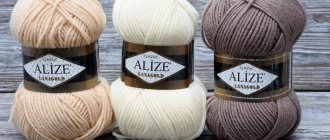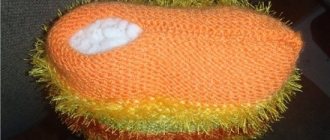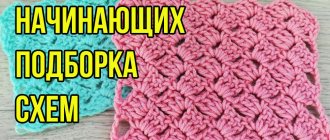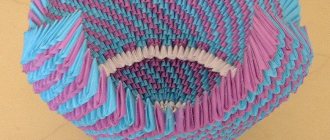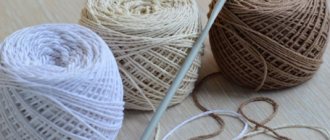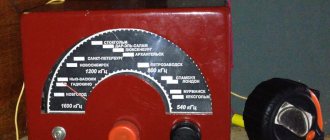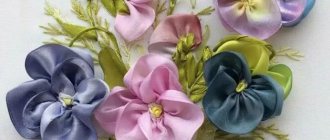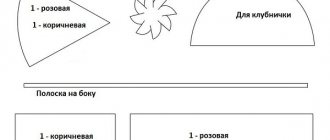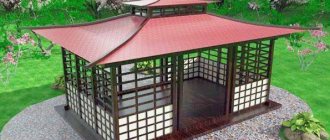Although many people argue that overalls are uncomfortable and impractical, I still disagree with this. There is something attractive about this piece of women's clothing, and if so, then it should be in every woman's closet.
However, a jumpsuit is a thing that is not suitable for every figure, so some women find it quite difficult to choose one in a store. There is only one thing left to do - sew the overalls with your own hands, tailoring the product to your individual characteristics. I offer ready-made jumpsuit patterns in two sizes - 38 (M) and 40 (L). Sewing difficulty level is easy. Therefore, sewing such a thing will not be difficult even for novice craftswomen.
What you will need:
- Any light fabric to choose from: silk crepe de Chine, viscose cambric or cotton satin - 2.6 * 1.4 m,
- Non-woven formband
Yarn selection
Yarn for children's overalls must be of high quality and consist of natural fibers. The baby's skin is delicate, so you should not choose yarn made from pure wool or cotton. The product will be prickly and rough.
It is better to use mixed threads with the addition of synthetics, which contain at least 50% natural fibers. They are softer and more pleasant to the touch and do not cause discomfort when in contact with delicate baby skin. You can use a mixture with acrylic or mercerized cotton.
Products made from blended yarn are more practical to wear, as they do not stretch or shrink after washing and have good thermal conductivity. A children's overalls knitted from woolen threads with the addition of acrylic will be warm, but not hot, the child’s skin “breathes” in it. Bamboo yarn is also suitable.
When knitting children's clothes, you should use yarn made from natural fibers.
Mohair, angora, lurex and polyamide should not be used for children's clothing. The yarn should be lint-free so as not to cause allergic reactions in the respiratory tract. It is better to choose hypoallergenic threads. This is usually written on the label. Yarn for children is often marked “baby”.
Choice of model, color, patterns
Knitted overalls for a newborn can be with or without a pattern, plain or multi-colored, with a hood, booties and mittens. It all depends on the taste, creativity and skill of the knitter.
When choosing a model, you can follow the following recommendations:
- For a summer children's outfit, it is good to use openwork inserts made of thin yarn. To add airiness to a summer jumpsuit, you can take knitting needles 1-2 sizes larger than required for the selected yarn. Then the knitting will be more loose and airy.
- For the cold season, a tight knit is suitable. You can use jacquard knitting. Be careful when using the Aran knitting technique. It involves voluminous shapes using braids and weaves. You should not use too voluminous patterns, because they will create inconvenience for the child.
Jacquard knit is great for warm clothes
- Often, for the baby’s comfort, a knitting technique without seams is used. When assembling the product, you can sew the seams outward to avoid chafing.
- When choosing a color for children's clothing, it is better not to use black or gray as the main one. They are best used for decoration or as a complement to other colors.
Products for girls are traditionally knitted from warm colors, for example, white or pink; for boys, blue or shades of blue are used. You can choose neutral colors - green, yellow, orange, brown, or use a combination of several colors.
- The color of the yarn should not be too bright. An increased content of dye in threads can cause allergic reactions in the baby. This yarn may shed.
- The style of the overalls largely depends on the time of year in which it will be used. Summer models can be sleeveless, with straps, and with short pants. For cold weather, a jumpsuit with a hood and closed rompers is more convenient.
- The bottom of the overalls should not be tapered, because it is necessary to leave room for a diaper.
- You can knit 1-2 sizes larger so that the clothes do not restrict movement and last longer.
A jumpsuit for newborns can be knitted 1-2 sizes larger - this way the item will last longer
- To diversify your baby's wardrobe, you can use a little trick. Knit two identical overalls from the same yarn. One is in stockinette stitch, the second is in garter stitch, when all rows are knitted with knit stitches. Jumpsuits even of the same color will look completely different.
- You can use the same pattern, just changing the yarn color, pattern or trim. The results will be completely different in purpose.
- It is better to choose comfortable and practical models that are quick and easy to put on and take off without irritating the baby and mother.
Pollo children's clothing
The Russian company Pollo is engaged in the development, production and wholesale and retail sale of beautiful and elegant clothes for newborns. The company has been specializing in sewing clothes for little ones only recently, but has already managed to establish itself as a worthy and competitive manufacturer of children's clothing. The product range includes a large number of children's clothing items, including for the little ones.
The company's production facilities are located in the Moscow region. Manufacturers carefully monitor the quality of their products. For clothing for newborns, only high-quality hypoallergenic fabrics are used that do not cause irritation and undergo special treatment. This is Polish cotton, satin, velor, guipure. All products are of very high quality, which is confirmed by relevant quality certificates.
The Pollo company has developed various models of clothing for babies: envelopes and various sets for discharge and for everyday use, clothes for baptism, diapers, blankets, vests, blouses, rompers, panties, hats, bonnets, headbands and bows for discharge for girls, overalls, bodysuits, sportswear, dresses, suits and other products. In a wide variety of products you can choose clothes for everyday use and elegant clothes for special events and celebrations. Pollo items are durable and wear-resistant; they do not need to be washed by hand - they can be washed in an automatic machine.
Pollo is the highest quality, fashionable and beautiful clothing for newborns. The Pollo brand is constantly developing and releasing more and more new collections, keeping up with the times. The colors and styles of the products are very diverse: delicate and bright shades, classic and cool styles.
A reasonable price-quality ratio and a huge selection of items attracts young parents to choose the Pollo brand. No one has yet been disappointed in the quality of fabrics and tailoring. That's why many young parents choose Pollo clothing.
Self-calculation
Before you start knitting, you need to draw a pattern for the overalls according to the baby’s size and knit a test sample. To create a pattern, you need to measure the circumference of the neck, chest, length of the legs and arms, and the height of the child.
The standard size for a baby from 0 to 1 month is 56. It is recommended to allow a size allowance of no more than 1-2 cm. Although a newborn grows quickly, clothing that is too large can cause discomfort. There are no design differences in products for newborn boys and girls.
To calculate increases and decreases for the pattern and the number of loops to be cast on, a test sample measuring 10x10 cm is knitted from the selected yarn.
Then you need to count the number of loops and rows. Some threads shrink or stretch after washing. Therefore, it is better to wet the test sample and measure it after drying and steaming. Then the calculation of the size of the finished product will be more accurate. If you don’t want to do the calculations yourself, you can always use ready-made patterns with detailed descriptions.
Determining children's sizes
In order for a pattern for a newborn to become a good basis for a future product, it is necessary that all the parameters not only correspond to reality, but also are suitable for the baby’s physique.
There are several nuances to consider when taking measurements:
- The baby should be dressed in light, thin clothing.
- The measuring tape should not be stretched too much, so as not to end up with clothes that fit close to the body.
- Record all data immediately after measurement.
Size chart
How to take measurements of a newborn:
- It is necessary to determine the height - the length from the heel to the crown.
- Chest circumference - place the measuring tape so that it passes under the arms and rests on the shoulder blades.
- You need to use the girth of the tape to determine the diameter of the waist in the tummy area.
- The volume of the hips is to grasp the buttocks at the most protruding part.
- The length of the back is from the middle of the neck to the place where the waist size was determined.
- The length of the arm is from the shoulder to the wrist when bent.
- Neck circumference - wrap the measuring tape around this part of the body with a sufficiently large overlap.
- The length of the foot is from the tip of the big toe to the heel.
- On the side, determine the length of the trouser leg - measure from the waist line to a certain level.
- Head circumference - place the tape so that it is located above the ears and lies on the eyebrows.
You need to learn how to take measurements correctly and know which parameters are especially important. If everything is done efficiently, taking into account all the recommendations, then the thing will turn out to be very comfortable for the baby.
In accordance with these parameters, the size of clothing for newborns is determined. Comparison of data will help with this; just select a table with sizes that are relevant in the country:
Selection of knitting needles and needles
The size of knitting needles is selected in two ways:
- According to the numbers that are on the label. Their size is always one larger than the yarn. For example, for threads with a thickness of 2, knitting needles No. 3 are suitable, and so on.
- Fold and lightly twist a strand of the selected yarn. The thickness of the knitting needles and the double twisted thread is approximately the same.
Overalls for a newborn are more comfortable and easier to knit on circular knitting needles.
In this case, the left and right parts of the product are in operation simultaneously. It’s easy to combine them into one canvas in the future. When knitting some patterns, you may need additional knitting needles to keep the dropped stitches on them. Experienced knitters use stocking needles in their work.
For work you can use plastic, metal or wooden knitting needles:
- Plastic ones are the lightest and most versatile, used for any type of yarn.
- Wooden or bamboo knitting needles are more suitable for openwork knitting, as well as for beginner knitters. Such knitting needles are less slippery and it is more difficult to “lose” loops on them.
- It is more convenient to knit items made of wool or acrylic on metal knitting needles.
In order to assemble the finished product, you will need a knitting needle. It differs from a traditional needle in having a wide eye and a blunt tip.
Choosing fasteners
The well-chosen method of fastening determines whether putting on the costume will be comfortable for your pet or not. The following can be used as fasteners:
- rivets - they are convenient to fasten on costumes for small dogs;
- Velcro (easy to fasten, but additional fastenings are required);
- laces (used on outfits of small breeds and do not need to be sewn);
- elastic bands (very versatile and can be used for dogs of different sizes and weights).
General recommendations for knitting
When knitting a jumpsuit, you should adhere to the following points:
- Before starting work, it is recommended to knit a small square from the selected yarn in order to calculate the number of loops per centimeter. This will help you not make a mistake with the size and choose the knitting density.
Knitting a sample helps calculate the number of loops and yarn
- For beginners in knitting, it is better to choose simple, solid-colored patterns without complex patterns or ornaments.
- The child grows quickly, so it is recommended to knit a slightly larger model.
- Particular attention must be paid to fasteners. They should be safe, not sharp, and easy to fasten. It is convenient to use zippers or buttons without legs.
- Under no circumstances should knitted overalls for a newborn be decorated with beads, rhinestones, brooches and similar accessories. Firstly, it is dangerous, and secondly, it will cause inconvenience to the child.
- For a model with a front clasp, it is enough to knit a strip of 4 additional rows.
- To make it easier to remove the diaper, you can not sew the inside of the panties, but make it with buttons or a zipper. For buttons, you can knit a strip of 3-4 rows, or sew on an elastic band.
- All parts must be steamed before stitching. It is better to start assembling the product from the shoulder seams. Then the side seams, sleeves and rompers are sewn together.
- Children's knitted items should be washed in warm soapy water. Squeeze without twisting, gently and lightly. When washing in a machine, use the delicate cycle.
- It is recommended to dry knitted items in a horizontal position to avoid deformation.
We take into account the nuances
- In addition to anatomical features, the gender of the animal should also be taken into account . The main difference between overalls for boys is the presence of a special cutout in the genital area. This cutout does not squeeze or rub. It is necessary for comfortable use of the overalls.
Pattern of overalls for a boy
- The choice of fabric depends on the season of use . Polyester is used for the autumn period. It protects well from rain and dirt. Bolognese material can be used for winter. Faux fur, fleece or plush are suitable as insulation.
- For long-haired breeds, it is recommended to use sliding fabric as a lining : satin, silk. Thanks to this, the wool will not roll or tangle. This move will ensure comfortable use of the overalls.
- When sewing winter clothes, sleeves and pants can be equipped with elastic bands . This will ensure that snow does not get under your clothes. The elastic band on the belly ensures a tighter fit to the body. Elastic bands that are pulled too tightly will cause discomfort when walking. Therefore, this detail should be approached very carefully.
- Various components can be used as regulators: buttons, zippers, Velcro, straps . The main thing is that they do not interfere with the pet’s movements. Velcro is not the best option in this situation: they quickly fail due to wool sticking to them.
The main requirement is the absence of discomfort when using the finished product. When sewing, carefully ensure that the overalls do not rub or squeeze the skin, do not interfere with the natural width of the step and do not restrict movement.
Conclusion
Overalls are an important element in a dog's wardrobe. It protects against harmful environmental influences, prevents the penetration of insects and serves as an effective decorative element. Sewing the product yourself will allow you to show maximum imagination and take into account all the features of your pet. This jumpsuit will be truly unique and as comfortable as possible.
Method from below
Most experienced knitters believe that it is easiest to knit a jumpsuit starting from the bottom.
This technique has its advantages:
- the method is suitable for any pattern;
- you can knit a raglan model either seamless or consisting of 4 separately knitted and then sewn parts (back, sleeves and 2 shelves);
- It is convenient to knit a product with one seam in the front, starting with rompers on double needles and then moving to circular needles,
- make set-in or seamlessly knitted sleeves;
- the ability to try on at any time and correct if there are errors in size;
- convenient to make different fastener options;
- the pattern is easy to enlarge;
- can be remade or tied, easily unraveling only part of the product;
- Using one pattern, it is possible to knit products for any time of the year, changing the pattern and density of the threads.
Outfit with a hood
In this section we will look at how to sew a dog costume with a hood. We will sew in the same way as described above. There is only one nuance in which we sew a tailored hood of a comfortable cut to the neck part.
For convenience, it is necessary to make it small.
It is recommended to insert an elastic band so that the hood can be tightened, so it definitely shouldn’t get in the way.
Let's look at the main points when sewing this component of the costume:
- The pattern is presented below. So, cut it out of paper. Apply to the fabric and trace. Cut out all the details;
- We place the visor parts face to face and machine stitch them;
- We turn the product inside out and process the part with an edge-to-edge seam along the curved side;
- Next, you need to sew the resulting visor to the hood itself.
The product is completely ready. Can be sewn to the neck part. As you can see, the visor tends to bend, thereby not interfering with the pet’s looking around. Models of suits with a hood are made mainly for toy terriers or chihuahuas.
Method from above
A jumpsuit knitted for a newborn can be created using raglan, starting from the neckline. In this case, the knitting goes in a circle.
An example of calculating the number of loops when knitting raglan from top to bottom
The “top” method has a number of advantages:
- parts do not need to be sewn;
- if you have to unravel the products, the thread remains intact;
- easy to lengthen as the child grows up;
- You can change the size during operation;
- circular or stocking needles are used.
Disadvantages of this method:
- For beginners, this method is difficult;
- it is not very convenient to knit, as it turns out to be a bulky fabric;
- you can make a mistake with the size and have to unravel the product completely;
- Not all patterns are suitable for circular knitting.
Purpose of workwear
Men's work overalls are special universal-purpose clothing that can be used in a wide variety of situations both at work and at home . However, in some enterprises wearing it is mandatory.
The distinctive features of this form of clothing are:
- Practicality. Work overalls are made of durable, non-staining fabric that is easy to care for.
- Functionality.
- Convenience.
Purposes of its use:
- Protection from high or low temperatures, radioactive and electromagnetic influences.
- Prevention of injury due to sparks and flames.
- Ensuring comfort when working with fatty substances, oils, petroleum products, acids and other chemicals and compounds.
- Protection from dust and other industrial contaminants.
Areas of application:
- In construction;
- When performing installation work (at enterprises of various profiles, in auto repair shops);
- In the food industry;
- When performing welding and electrical installation work;
- In the chemical, furniture and processing industries;
- In agriculture, etc.
Simple overalls for baby
Even a less experienced mother can knit a simple jumpsuit using garter stitch. The product is knitted with knit stitches on both sides and is delicate, soft and cozy.
Mixed threads that include cotton, linen or bamboo are suitable for this model. To make the overalls warmer, you can use thin wool with acrylic. For size 56 cm you will need 150 g of yarn, 14 buttons and circular knitting needles No. 3.
Knitting order:
- The control pattern should have 28 stitches and 56 rows.
- The trouser legs are knitted from the bottom. For convenience, you can knit them simultaneously from different balls. Cast on 26 loops and knit 1.5 cm with a double elastic band (knit 2, purl 2).
- Add 1 stitch in the last row.
- Knit in garter stitch 29.5 cm.
- On the inside of the sliders in each leg for the crotch seam, add: 1 loop once, 1 loop after 3 rows and 1 more loop after 3 rows.
- After 11.5 cm, combine both legs, adding 3 loops between them for the crotch seam.
- Knit in garter stitch 29.5 cm.
- For armholes, decrease on both sides 1 time 2 loops, 6 times 1 loop each
- After 39.5 cm for shoulder bevels, close 5 loops once
- Cast off 5 stitches every other row.
- Cast off 4 stitches every other row.
- At a height of 40.5 cm, close off the remaining loops. The back is ready.
- Knit the front legs in the same way.
- Combine both halves by knitting 3 crotchet stitches between them.
- Knit 18 cm in garter stitch.
- Slip 21 stitches in the center of the fabric onto an additional needle.
- Knit the armholes and bevels of the front in the same way as the back.
- Close the loops.
- Knit the remaining central loops on the additional knitting needle with the main pattern
- After 38.5 cm, close the loops.
- For the sleeves, cast on 42 stitches and knit 1.5 cm with an elastic band.
- Add 2 stitches on the outer row.
A jumpsuit for newborns can be knitted with knitting needles using the simplest pattern - garter stitch.
- After 22 rows for bevels on the sleeves, add 1 loop on both sides 3 times in each 10th row. Then in each subsequent 8 row there are 3 loops.
- Having knitted 11 cm, close 7 times with 1 loop.
- Cast off all stitches, knitting only 13.5 cm.
- Pick up 70 stitches for the front trims and knit 6 rows with an elastic band. Make 7 loops on each of the planks. To do this, knit 2 loops together, then yarn over, in every 3rd row
- Sew and wash the finished overalls. Dry in a horizontal position so that the knitted product does not stretch or deform.
For a simple jumpsuit, you can use a single color yarn or several colors. For example, knit the main part in one color, and the cuffs and front trim in another. This will refresh and diversify the model.
Summer overalls for girls
A knitted jumpsuit for a newborn with straps and short pants can be created in a few hours. This model uses 2 thread colors. The knitting density is 28 loops and 40 rows in the control sample. You will need 1 skein each of white and yellow acrylic yarn with elastane, 5 snaps and 2 buttons.
The length of the overalls is 27 cm, including 1 cm elastic, width 14 cm at the neck, 22 cm at the chest and 24 cm at the hips. The pattern is not difficult to perform; even those without much knitting experience can handle it: the front rows are knitted with knit stitches, the purl rows with purl loops. To combine colors, knit alternately 2 rows of white and yellow yarn.
In order to knit the right bar, you need to make decreases: knit 1, knit 2 loops together with a tilt to the left (slip 1 loop as a knit stitch), knit 1. pull through the removed loop. When there are 4 loops left on the knitting needle, knit the middle 2 stitches together and bind off. Knit the left bar similarly to the right one.
Winter overalls for newborns
For winter overalls, a model with a hood is suitable, which is convenient to put on over a hat. It is better to choose dense yarn for warm overalls, made from wool or polyamide with the addition of acrylic.
A simple “checkerboard pattern” looks advantageous in a single-color version. More experienced knitters will be able to diversify the pattern by knitting “checkerboards” using yarn of different colors. It is worth considering that the overalls will become thicker due to pulling the threads from the wrong side.
Rapport consists of 10 loops (K3, P3) and 10 rows. The knitting density is 16 loops per 22 rows in the control sample 10x10 cm.
The procedure for knitting overalls with a hood:
- For the left half, cast on 18 stitches on needles No. 4.5 and knit with an elastic band (K1, P1) 2 cm.
- With the main pattern, starting with knit 2, knit 4 cm and add one loop to the right 3 times in every 6th row. You need to start increasing after 5 loops from the edge. The result will be 21 loops.
- Knit the right part in the same way. Start the pattern from the first repeat loop.
- Connect both pant legs onto one knitting needle.
- Knit 18 cm and bind off on both sides 2 times, 1 stitch in each 10th row.
- At a height of 28 cm from the start of knitting, close 2 loops on both sides.
- Cast off all the loops when the length of the product is 36 cm.
- When knitting the right trouser leg, after 12 cm, cast on 2 loops and knit 3 purl, 2 times 2 together with knit stitches.
- Next, knit similarly to the left leg.
- For the sleeve, cast on 23 loops and knit with a 2 cm elastic band.
- Continue with the pattern 6 cm and add 2 times on both sides, 1 loop in each 8th row.
- After 13 cm, put off knitting.
- For the hood, cast on 61 loops and knit 2 cm with an elastic band.
- Start the main pattern with 2 loops of the pattern.
- In each 2nd row, cast off 1 stitch 5 times.
- At a height of 11 cm from the beginning of knitting, close in each 2nd row 2 times 4 loops, 3 times 3 loops.
- Cast off remaining stitches. The hood is ready.
Wash all parts in soapy water, dry and steam. Start assembling from the shoulder seams. Sew the hood along the back seam and sew it to the neckline, leaving 7 loops on both sides from the edge of the front. Then sew in both sleeves. Sew side seams and sew buttons.
This outfit is suitable for a child of any age. You just need to increase the pattern by a few centimeters. For the smallest size you will need 4 skeins of plain yarn and 4-5 small buttons.
Option for winter overalls with braids for a newborn
The good thing about the model is that the pants can be sewn along the crotch seam, or made with fasteners so that you can change the diaper without taking off the entire overalls. To do this, knit a placket for buttons or snaps along the inside of the trousers. It is more convenient to use buttons, since they do not require knitting loops.
Openwork transformable jumpsuit
A transformable jumpsuit is an envelope that, with the help of fasteners, can be turned into a full-fledged jumpsuit. The advantage of the model is that it can be used for a long time.
As an envelope, it is perfect for discharge from the hospital and the first month of life. In such a “bag” the child sleeps warmly and comfortably. As the baby grows up, it will become more convenient to wear it in the form of a onesie with rompers.
The pattern for a transformer measuring 54 cm is a rectangle 15 cm wide and 54 cm high, with a bevel for the sleeve and neckline. This is half the front or back. The jumpsuit is knitted from 4 parts. The full neck diameter is 12 cm, the armhole height is 14 cm. The sleeve in this model is set-in and knitted separately. The width of the half sleeve is 12.5 cm, the length from the armhole is 15 cm, the wrist is 7 cm.
The product can be knitted either from below or from above using raglan. With this option, cast on 18 loops at the rate of: 18 loops for the back, 9 loops for the sleeves, 2 times 8 loops for the shelves. To increase the overalls pattern, just add a few centimeters to the length of the product and sleeves.
For those who are just learning to knit, you can use a simple openwork pattern consisting of knit stitches and yarn overs. The purl rows are knitted according to the pattern, the yarn overs are knitted with purl loops.
The size of the repeat is 10 loops and 12 rows, so it is easy to calculate the number of repetitions of the pattern for any size.
Assembly of the finished product:
- connect the main part and sleeves;
- perform side seams;
- sew the back 44 cm starting from the neckline;
- sew or tie a button placket on the front, along the crotch seam on the back and bottom edge of the overalls.
How to sew a children's vest: patterns, sewing instructions, photos, videos
Fabric for sewing a vest
- While most adults can wear synthetic fabrics without any discomfort, children need high-quality materials. Manufacturers of children's clothing prefer cotton flannel or chintz.
- The main thing is that the material must be 100% natural. When purchasing fabrics, you should check with the seller for a quality certificate.
- Vests should be sewn from high-quality white fabrics. This is due to the fact that they are not pre-coated with dyes, which can cause allergies in the child.
Sewing a vest
In addition to cotton, chintz and flannel, you can use the following materials for sewing a vest:
- madapolam
- batiste
- paper
Construction of a vest pattern
- Now we will tell you how to sew a wrap-around vest that will be secured with a button or button.
- After you decide on the material (be sure to take into account seasonality), you can transfer the pattern to the fabric. The pattern you like can be found on the Internet for free.
- If the pattern is intended for children aged 2-3 months, and your child is a little older, then you can increase the pattern to the size that is needed.
- First of all, decide on the length of your clothes. Measure the distance from shoulder to hips.
Step-by-step pattern instructions:
Home Description
Sewing a vest
Step-by-step instructions for sewing a vest:
- When the patterns are transferred to the fabric, all the details need to be cut out.
- Sew the vertical section of the sleeve.
- Pin the shirt tab to the shelf using a pin.
- Connect all the elements and stitch them.
- Sew the bottom of the vest and the neckline.
- To keep the shelves in place, buttons or buttons are attached to them. The loops into which the buttons will be inserted need to be sewn.
Sewing a vest
The length of the sleeve
It is important to determine the correct sleeve length so that the child is comfortable. If you are going to sew a vest with short sleeves, then 7 cm will be enough.
If you plan to wear a vest with scratches, then you need to add another 4-5 cm to the total sleeve length
This will protect your baby from injuries caused by marigolds.
Models for growth
A newborn baby grows quickly, gaining up to 25 cm in height in the first year of life. To make the overalls last longer, you can use a few tricks from experienced mothers.
Secrets:
- Tie a loose elastic band on the sleeves and trousers 2 times longer. When the child is small, you can wear clothes with a lapel. Then straighten the lapels if necessary. This will add length to the product.
- Can be made into folds ranging in size from 2 to 6 cm in the waist area and on the sliders. This method is not suitable if the product is knitted from dense yarn or with a convex pattern, because it may cause discomfort for the child.
- In the summer version of the overalls, knit longer pants and straps. Then you can increase the size by adjusting their length. And trousers will eventually become shorts.
- With the top knitting method, it is possible to increase the overalls by several sizes. To do this, you need to unravel the part of the product that has become small and knit it longer.
A jumpsuit knitted by yourself looks original, unique and pleases with its uniqueness. When choosing a model, you need to remember that clothes should not only be beautiful, but also comfortable. This is important for both the newborn and his mother.
Article design: Natalie Podolskaya
How are slips different?
A slip is a unique tandem formed by a vest and rompers. It combines the advantages of both garments:
- Provides protection for the baby's back.
- does not fold or move, even if the baby is active.
- does not squeeze the tummy, as it does not have an elastic band.
- saves time when changing a diaper, since the overalls are equipped with buttons on the gusset (between the legs).
- looks very attractive and can be quite affordable.
- has a summer modification - a bodysuit. This is a T-shirt and panties combination.
Slips are sewn from knitted, velor fabric or fleece. There are also terry models - these are overalls with buttons (buttons) with long sleeves. There are lighter models for newborns - they are called bodysuits. This type of jumpsuit has short sleeves and looks like panties at the bottom.
Another feature that distinguishes slips is their simple cut. If a young family does not have enough money to buy a sleepsuit, then you can sew it yourself for discharge. The pattern is easy to make and sewing is also not difficult.
